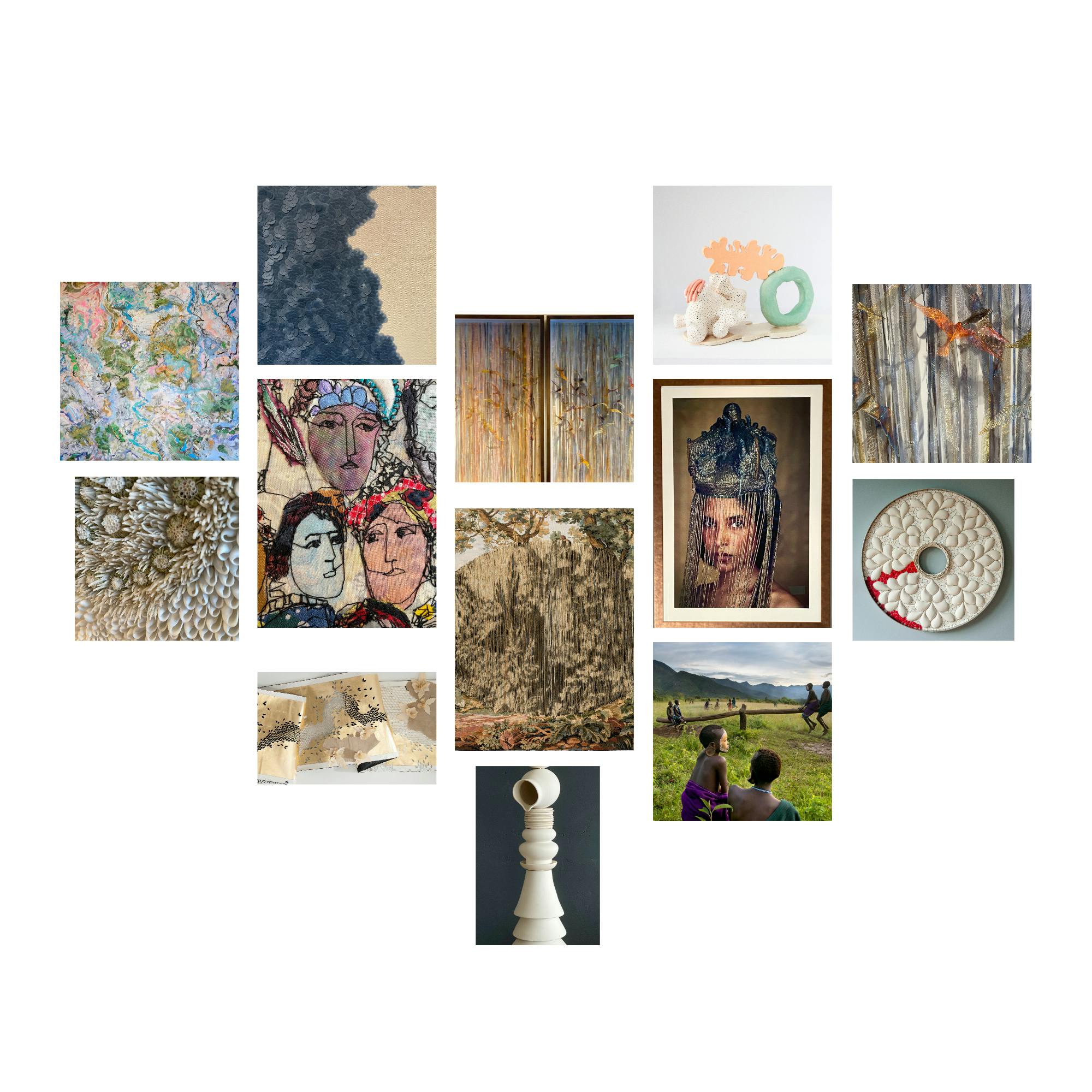Here’s Why You Should Take the Stairs on the New Silver Nova
People who take the stairs between decks on the Silver Nova will be richly rewarded – and not just by their step-counters.
On Silversea’s newest and largest luxury cruise ship, which launches Aug. 14, the number of art pieces (1,766) is more than double the number of guests (728). My advice: Head to the carefully curated stair landings that span 11 decks for a vertical showcase of artists from around the world (and a chance to get in some cardio). The vertical gallery spans the aft stairs from Decks 2 to 9 and forward stairs from Decks 5 to 11.
Mariangela Capuzzo, chief creative officer of International Corporate Art, or ICArt, and her team commissioned most of the work to create a collection like no other. Its theme? Silver Nova: A Guiding Star, which is meant to to shine a fresh light on a new way of sensing, being and discovering.
Capuzzo took particular care with the choices for the stair areas on either side of the ship, where the art is grouped by themes based on fire, water, Earth and air, the four elements.
Why did she go to so much effort creating galleries within stair areas onboard Silver Nova? “The architectural nature of the stairs, their verticality, provide a perfect opportunity for a museum like experience,” she tells me. “As you stroll down the stairs, there’s a chance for discovery. Exploration comes alive, thus inviting a close-up experience.”
‘As you go from deck to deck, there is a rhythm that is achieved in terms of color and form.’
Mariangela Capuzzo, chief creative officer, ICArt
Forward stairs contain works with an Earth and fire vibe, displaying pieces with warm colors – including brown, rust, red, ocher and gold – using metal, ceramic, wood and painted media. The aft stairs reflect a lighter water and air motif, and those works show cooler hues – magenta, violet, indigo and turquoise – and are made with such materials as paper, textile, shells, feathers and glass.
“As you go from deck to deck, there is a rhythm that is achieved in terms of color and form,” Capuzzo says. “There is a flow to the selection of artwork. There is a flow in terms of color.”
The resulting mini-gallery featuring artists from 11 countries is designed to take passengers on a cultural journey before they ever step off the ship. Capuzzo described many of the framed pieces as process-based, in which you “see the artist’s hand” in a variety of media.

One example: artist Mónica de Miranda’s meticulous pattern embroidered onto a large horizontal photograph of the ocean. The effect allows the viewer to peer at the seascape through threaded windowpanes, admiring the view and the craft.
The chief creative officer, who has worked on art projects for more than 25 ships, shared her thoughts on some of the pieces that adorn Silver Nova’s stairs. All photos are courtesy of ICArt.
‘Bleeding and Phantom Flower,’ by Canadian artist Marie-Andrée Côté

“What is fabulous about her work is the attention to detail,” Capuzzo tells me. “She takes ceramic to another level by re-creating nature through ceramics. So you have the fragility of nature and the fragility of the medium, which come together to celebrate, in a beautiful fashion, nature, the organic, the ephemeral.”
‘Untitled, Delta Series,’ by Argentine artist Kico Camacho
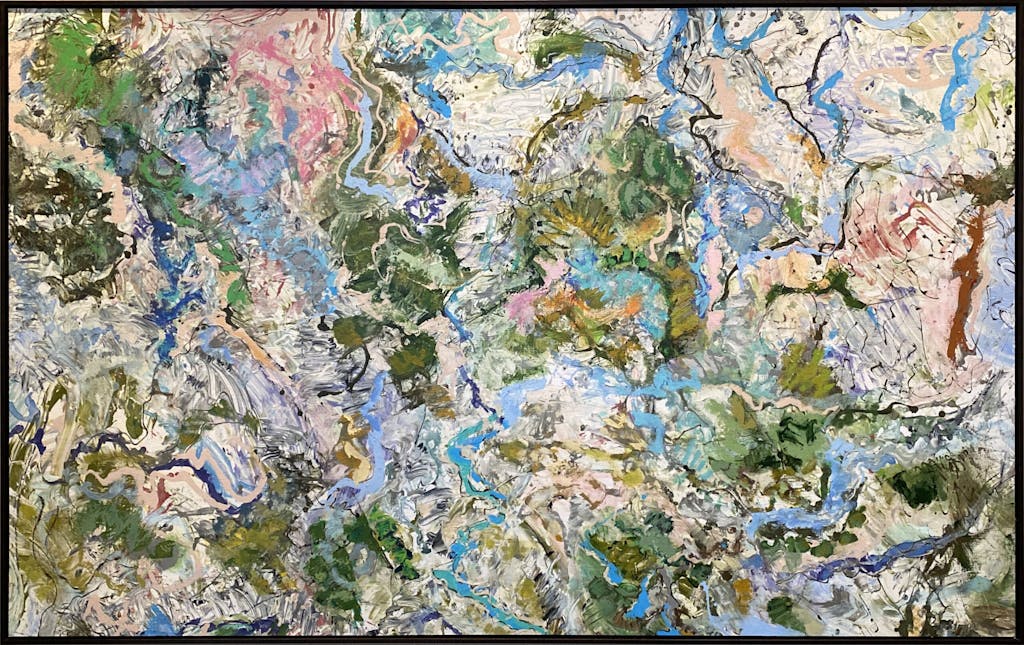
“Kico is a painter for painting’s sake,” Capuzzo says. “His works are really textural, really a mastery of combining color and movement. It really brings you into the magic of color and form. It’s an abstract expressionist piece but with a lot of texture.”
‘Lessons for Restoration (Perspective) 4,’ by Japanese artist Aiko Tezuka

“What’s fascinating to me about Aiko’s ‘Lessons for Restoration (Perspective) 4,’ is how she appropriates Florentine tapestry and unravels the center,” Capuzzo says. “In doing so, she intervenes in something that’s old to bring her own new sensibility to the work.”
‘Yoruba Crown,’ by French Senegalese artist Delphine Diallo

“Everybody loves that piece,” Capuzzo tells me. “Delphine basically elevates women in her work and creates, out of every one of us, goddesses.”
More on Delphine: “She is born into a French Senegalese artistic family and is based in Brooklyn. Meeting the famous photographer Peter Beard (1938-2020) inspired her to use photography as a tool for deconstructing the sexist and racist legacy tied to the medium. She started by portraying friends and family and turning them into goddesses as a way to honor what she calls ‘the divine female body.’ Since 2014, she has been creating a visual language that would empower herself and the women that would become her heroines.”
‘Untitled,’ by Iranian artist Batool Showghi
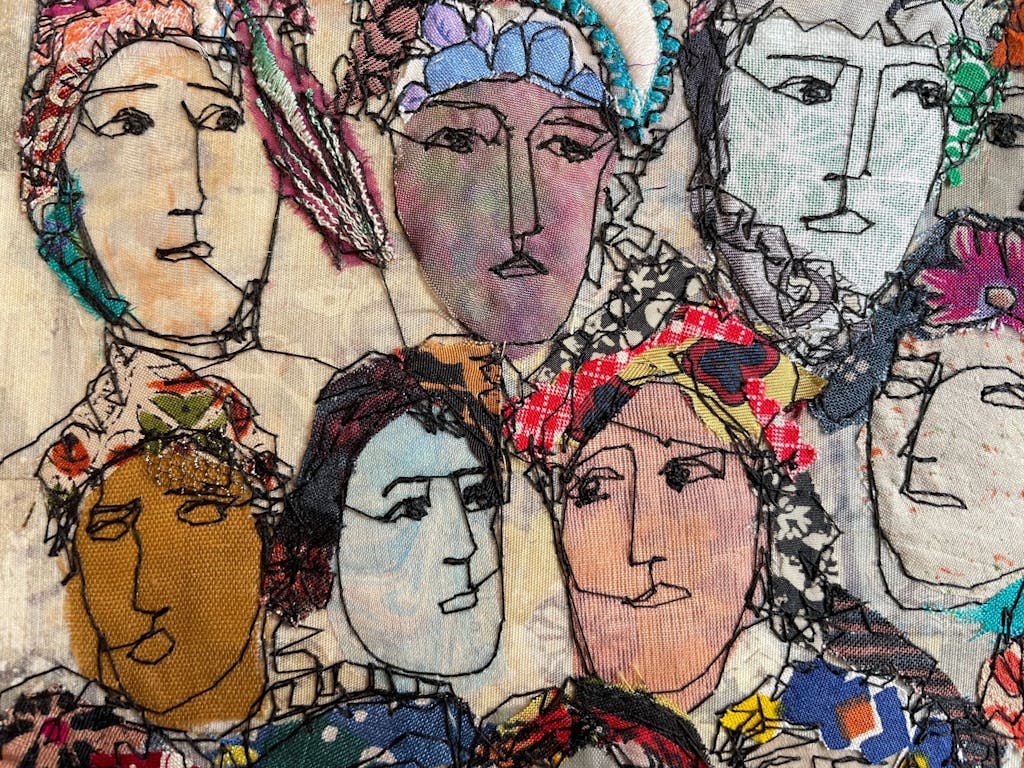
Batool’s artwork is concerned with her cultural heritage, memory, identity and loss,” Capuzzo says. “She wants to examine the physical limits that women can experience with regard to cultural and religious boundaries.
“She frequently returns to Iran to draw inspiration and source new material. Her vocabulary is diverse and she transforms documents, calligraphy, portraits, patterns and everyday objects into beautiful and densely layered pieces. She works with photographs, digital manipulation, fabric, stitching, paint and paper to produce her unique and individual images and pieces in a process that has become a ritualized activity.”
There’s more. “The collection of 39 boxes exhibited on Silver Nova,” says Capuzzo, “is one of her projects during the confinement that shows people being isolated in a room or their house separated from each other.”
‘Borderline Perfect,’ by Korean American artist Timothy Hyunsoo Lee
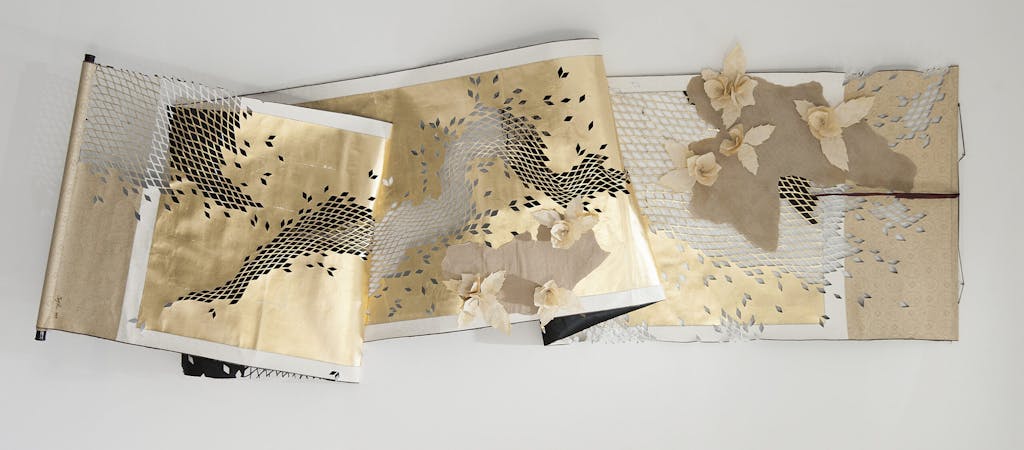
“Timothy Hyunsoo Lee grew up in the Boston area and studied biology, so he sees the world through a microscopic eye,” Capuzzo says. That means “he dissects everything, and he’s kind of dissecting his culture.” (Another work by Lee spans three decks of the ship’s stairs, featuring a gold-leaf abstract triptych and a large piece with 39 transfer photos on metal.)
‘Chrôma I, II, III,’ by Madrid artist Carmen Castañeda
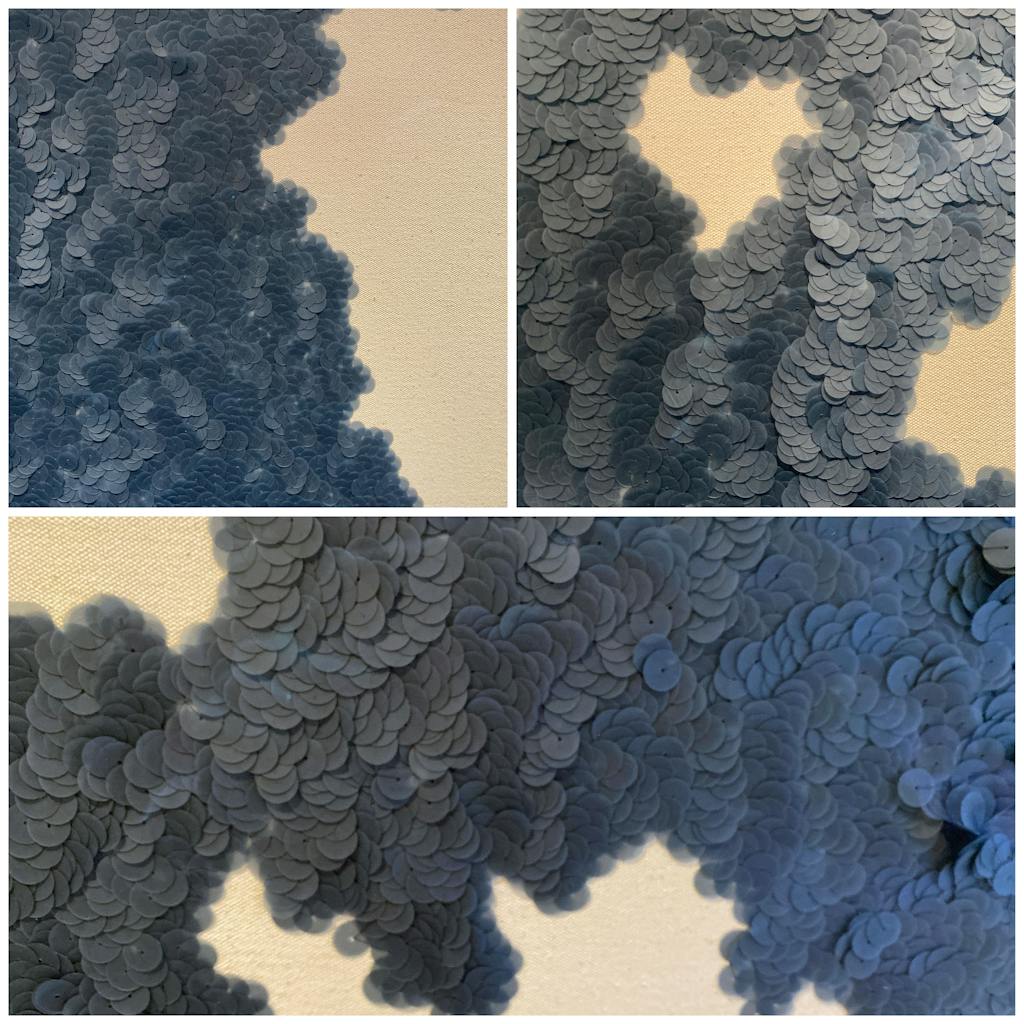
Capuzzo tells me that in this sequence of pieces made from thread on organza, you are looking down on the topography of the Earth, and what’s unusual is the artist’s background. “Carmen studied haute couture embroidery techniques before she became an artist, and you can see the discipline has become the basis of her artistic language.,” Capuzzo says. “We love this piece because it’s process-based, exploring the abstract nature of time. Don’t miss the sequin maps.”
‘Cromarty,’ ‘Untitled,’ and ‘Rockhall,’ by British artist Blott Kerr-Wilson
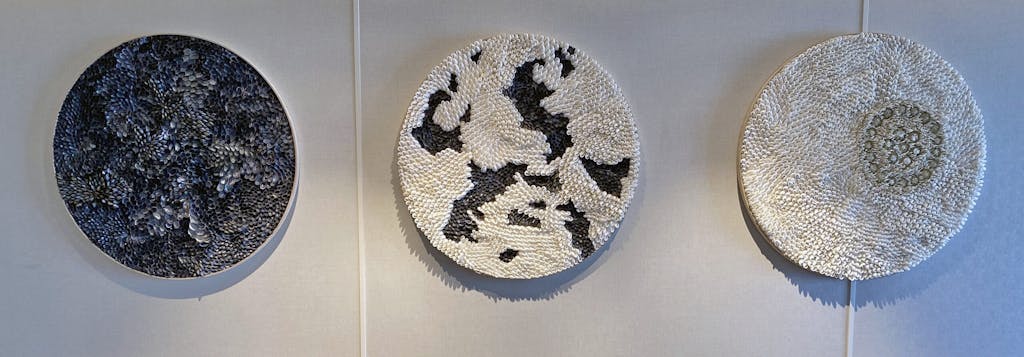
Blott Kerr-Wilson grew up in North Wales and is fond of collecting shells from different beaches in England, and fashioning them into art pieces. Her shelling career began when she created her first shell interior in her small council flat bathroom in south east London. She entered the bathroom into a competition in the prestigious magazine The World of Interiors. And she won.
“Blott has not looked back since and now travels the world creating huge bespoke shell installations and individual artworks.,” Capuzzo says
“You can see that her individual art pieces are informed by the mathematical nature of shells, their movement and color.”
‘Untitled,’ by British artist Michelle McKinney
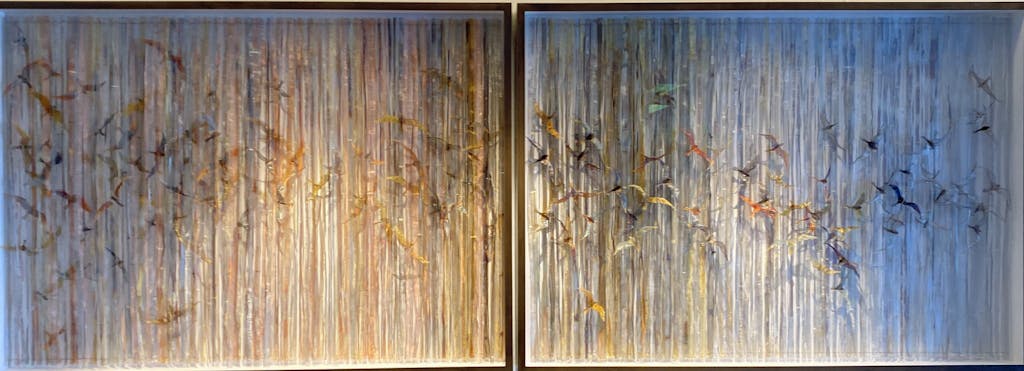
“She studied jewelry design and jewelry-making,” Capuzzo says, “so she uses copper filaments and gold filaments and transparent paper to create her pieces. Again, very process based.”
